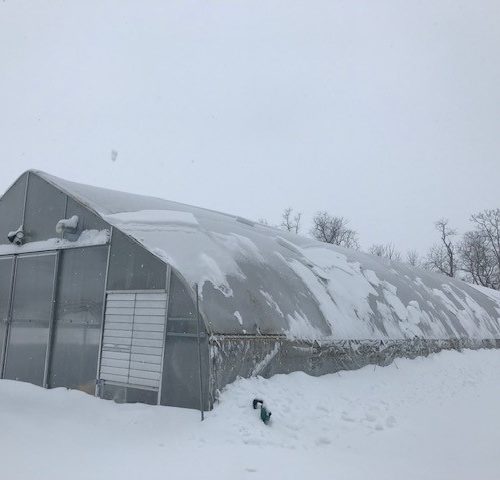In 2017, as we began our work to support food security in the District of Columbia’s Wards 7 and 8, we quickly learned there was a lack of data regarding total produce distributed in these communities. We knew there was a need for healthy food, but this lack of data hindered progress toward potential solutions.
To address this data gap, in 2018 we surveyed and convened organizations that distributed whole, take-home produce in Wards 7 and 8 through nongrocery sources (e.g., farmers markets, food banks) in 2017. Through our multipart Insights Series, we shared our findings along with secondary research and perspectives from others working toward equitable food production, distribution and access in D.C.
This blog post provides an overview of the series. Read the entire series here.
Introduction
In communities with limited access to grocery stores — including D.C.’s Wards 7 and 8, which have three grocery stores for roughly 165,000 residents — other nongrocery outlets play an important role in providing healthy food (including produce). In 2017, participants of our Produce Distribution Survey distributed about 2.18 million pounds of produce in Wards 7 and 8 through these types of nongrocery outlets. While both paid and free models were represented in this total, the majority was distributed for free through models like food banks/pantries, education programs and nontraditional community-supported agriculture (CSA) programs.
While this total represents a sizable amount of produce and spotlights the important work of these organizations in building a more equitable food system, it provides only a partial picture of the supply of healthy food and our distribution-focused survey did not speak to community needs and preferences. To close the series, we will review three key themes that are introduced in this series, but which require further exploration to create an equitable food system in Wards 7 and 8 and our region.
Theme 1: Enhancing data quality and connectivity along the food supply chain
This series explored a number of challenges with data: metric consistency, capacity gaps, proprietary or costly data for private sector distribution, etc. Data gaps were a key motivation for the original survey, but this process revealed that many other actors — survey participants and entities along the regional supply chain — also struggle with data issues. Per Lindsay Smith of the Metropolitan Washington Council of Governments:
“Some of the challenges [with data collection in our regional food system] have to do with the data itself, while others are related to resources available to analyze data and to address regionally specific questions. There aren’t a lot of resources invested in on-going, regional data analysis on food and agriculture. There is data that isn’t collected in a standardized way yet.”
These challenges limit our understanding of how well the regional food system is positioned to meet consumer demand in an equitable way.
Theme 2: Evaluating interactions between different distribution efforts
The lack of data in this space creates two complicating factors: We don’t know the interaction between different distribution models (particularly those that aim to serve the same residents), nor do we have a sense of the affordability of these models for the consumer.
Survey participants discussed the interaction between paid and free models. Emergency food and free food distribution are crucial to ensuring reliable food access for those with limited or no income. For instance, George Jones, CEO of Bread for the City, says his organization typically serves households with incomes of less than $10,000 per year and with three or four household members.
Though a critical source of produce, free produce distribution may be having an unintended adverse effect on the marketplace. Beverley Wheeler, Director of D.C. Hunger Solutions, notes:
“We do not know what dampening effect, if any, free produce distribution is having on produce supply and demand. For example, there is so much free produce distributed in Wards 7 and 8 that there is no incentive for some farmers markets to bring in a lot of food. If [markets] thought they could sell more produce, they might bring more produce and subsequently more overall produce could be distributed. It is almost a microcosm of the grocery gap. There is a belief that people won’t buy/participate so grocery stores are not built, further limiting food access.”
In addition to the challenge of understanding the interaction between distribution models, many participating organizations face challenges understanding what was “affordable” to customers and are seeking to better understand how to different models can work together as a spectrum to comprehensively serve different needs in the community.
Theme 3: Building the local food system through a community-development lens
This survey and convening examined the pounds of fresh, whole produce distributed through participating nongrocery sources, but we know food availability alone does not achieve equity and inclusivity in the D.C. food system. Other important factors — such as the quality, nutrition and cultural appropriateness of this food; the level of community input and ownership; and the economic inclusivity/implications of these models — were not examined at all or in depth in this study.
Food access efforts in Wards 7 and 8 need to include a spectrum of opportunities for community members to lead, manage, own and/or provide input into how new services are designed and how existing services are improved to better meet resident needs. These efforts also need to be created within the context of the various needs and preferences of the community in order to create opportunities for engagement that are accessible and fit with their schedules. Community-led development requires providing necessary financial capital and support; however, there are massive inequities regarding who receives funding. According to the Philanthropic Initiative for Racial Equity, in the United States, annual foundation funding focused on reaching people of color has never exceeded 8.5% and, as of 2014, was 7.4%. Therefore, a community-centered approach is a critical component to support communities that have been historically disenfranchised and underserved by the mainstream food system.
Thank you
We are grateful to all the organizations that participated in the 2017 Produce Distribution Baseline Survey and subsequent convening.
To learn more about food access in Washington, D.C., and the Foundation’s Produce Distribution Survey, check out the links to each part of the Insights Series below.
- Part 1: Challenges and Opportunities in Food Distribution Data
- Part 2: How Much Food and How Is It Distributed?
- Part 3: Challenges and Opportunities in Food Procurement
- Part 4: A Continuum of Distribution Models
We would also like to take the opportunity to spotlight some of the ideas and recommendations that participating organizations had for collaboration, from aligning on shared data metrics to minimizing barriers to accessing funding. (Click here for more information.)
To learn more about food production, access, distribution and sovereignty, check out these resources:
- 2018 Food System Assessment by the DC Food Policy Council
- Beginning Farmer and Rancher Development Program and the Outreach and Assistance for Socially Disadvantaged Farmers and Ranchers Program by the USDA
- Chesapeake Foodshed Assessment by the Harry R. Hughes Center for Agroecology
- Community Food Guides by DC Greens
- Dismantling Racism in the Food System by FoodFirst
- Edible Activist hosted by Melissa L. Jones
- Equitable Development Toolkit: Local Food Procurement by PolicyLink
- Farmers Market Nutrition Program by the USDA
- Food Economy Study by the DC Food Policy Council
- How America Treats its Black Farmers by The Guardian
- Hunger Heat Map by Capital Area Food Bank
- Lunch Agenda hosted by Kiko Bourne
- Produce Plus Program by DC Health
- Racial equity is good for food business by the Kellogg Foundation
- Resource Guide for Funders: Sustainable Food Systems Organizations Led by People of Color and Indigenous Communities by the InDEEP Initiative
- Shifting Neighborhoods: Gentrification and cultural displacement in American cities by National Community Reinvestment Coalition
- State of the Work: Stories from the Movement to Advance Diversity, Equity and Inclusion by the D5
- Virginia Beginning Farmer and Rancher Coalition by Virginia Tech
- What Our Region Grows by the Metropolitan Washington Council of Governments





